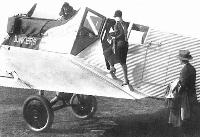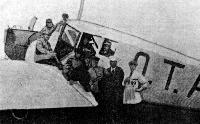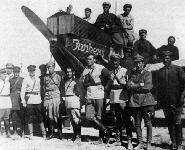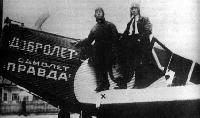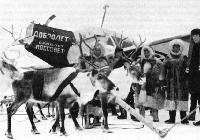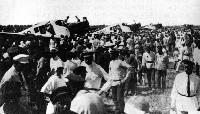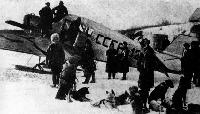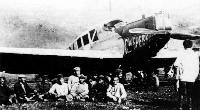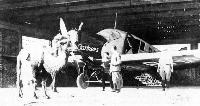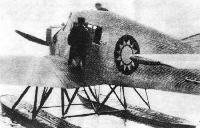В.Шавров История конструкций самолетов в СССР до 1938 г.
"Юнкерс" Ю-13 - всемирно известный пассажирский шестиместный самолет (4 пассажира). Двигатель - БМВ-IIIа в 185 л. с. на высоте 2000 м и с эквивалентной мощностью 240 л. с. у земли. Этот самолет, выпущенный в 1919 г., по своей схеме, компоновке и внешнему виду выделялся среди других самолетов 20-х годов, был экономичен и имел хорошие летные качества. При более мощных двигателях на нем был установлен ряд рекордов. Ю-13 появился в Москве в мае 1922 г. Несколько экземпляров Ю-13 эксплуатировались на аэролинии Москва-Нижний Новгород во время ярмарки в 1922 г., а также в 1923 г. В том же году было куплено 10 экземпляров этого самолета для "Добролета", который использовал их на воздушных линиях Москва-Казань, Ташкент-Алма-Ата, Ташкент-Бухара, Бухара-Хива и Бухара-Дюшамбе. Было выполнено несколько больших перелетов. Ю-13 применялись в школах и в сельскохозяйственной авиации. Всего было до 20 импортных экземпляров. Кроме того, в Центральном парке-складе "Добролета", где был налажен их ремонт и восстановление после крупных аварий, были построены из советского кольчугалюминия пять совершенно новых экземпляров.
Два Ю-13 были установлены на поплавковое шасси, подобное Ю-20. Один из них применялся осенью 1923 г. для платных полетов на Москве-реке у Сельскохозяйственной выставки. С 1926 г. Ю-13 стал заменяться самолетами типа Ф-13, которые при тех же размерах отличались формой хвостового оперения и меньшими размерами окон пассажирской кабины в связи с преимущественно грузовым назначением самолета. На нем был установлен двигатель Л-5 в 310 л. с. Было несколько экземпляров.
Самолет||Ю-13/Ю-13 гидро/Ф-13
Год выпуска||1919/1922/1924
Двигатель , марка||БМВ-IIIa/БМВ-IIIa/Л-5
мощность, л. с.||185/185/310
Длина самолета, м||9,6/10,3/10,1
Размах крыла, м||17,8/17,8/17,8
Площадь крыла, м2||38,7/38,7/40
Масса пустого, кг||1150/1300/1200
Масса топлива+ масла, кг||200/150/400
Масса полной нагрузки, кг||650/600/900
Полетная масса, кг||1800/1900/2100
Удельная нагрузка на крыло, кг/м2||46,5/49/52,5
Удельная нагрузка на мощность, кг/лс||9,8/10,3/7
Весовая отдача,%||36,1/31,6/43
Скорость максимальная у земли, км/ч||155/150/180
Время набора высоты 1000м, мин||8/9/7
Время набора высоты 2000м, мин||17/20/15
Время набора высоты 3000м, мин||28/40/25
Время набора высоты 5000м, мин||?/?/60
Потолок практический, м||4500/3500/5000
Продолжительность полета, ч.||5/4/5
Показать полностью
A.Kay Junkers Aircraft and Engines 1913-1945 (Putnam)
After the First World War
Even before Armistice Day signalled the end of the First World War on 11 November 1918, Hugo Junkers was looking forward to the development of transport aircraft and the worldwide development of airlines. It can be said that he was the father of Germany’s air transport system which, alongside others, spread over much of the world and created other airlines.
The J12 passenger aircraft was in development before the end of the First World War but was terminated soon afterwards when work began on the J13, later to become the F13. From the viewpoint of today, this aircraft with its crew of two and room for four passengers seems too small to be a commercial success, but this proved to be far from the case. Despite the fact that the aircraft was far in advance of its contemporaries, initial sales of the F13 were poor owing to Allied restrictions and the surfeit of military aircraft following the war. In fact it was not until 1919 that the first orders, for six, arrived from the United States; these, however, were confiscated by the Inter-Allied Aeronautical Commission for Control since it was considered that the F13 could be used for military purposes. (Much later, the Luftwaffe did use F13s for transport duties.) The Commission reversed its decision in February 1920 and then active promotion of the F13 began. A primary means of this promotion was the establishment by Junkers, in 1921, of its own airline - the Junkers-Luftverkehr, which later merged with Deutscher Aero Lloyd to form Deutsche Luft Hansa on 6 January 1926. A training school for pilots was also established and many schemes were begun to help companies all round the world establish fledgling airlines and air transport services. F13s appeared with wheels, floats and skis according to the dictates of operational conditions.
Junkers J13 (F13)
When the design of the J13 was begun in 1919 it was to become not only the world’s first all-metal airliner but also the forerunner of all commercial transport aircraft. Despite the enforced destruction of more than 15,000 military aircraft and 27,000 engines, the postwar market had plenty of surplus aeroplanes which could be bought cheaply, and Junkers realised that something special was required for commercial success. Fortunately, by now the company had considerable experience in light metal working and many patents to draw upon, and these were to give the edge over the many wooden aircraft then extant.
It now fell to Dipl.-Ing. Otto Reuter to design the J13, and he produced a single-engined, low-wing, cabin monoplane of quite small dimensions since it was necessary to work within the onerous restrictions diligently forced upon Germany by the victorious Allies. For civilian aircraft, these restrictions included a maximum speed of 170kph (105mph), a ceiling of 4,000m (13,120ft), a payload of 600kg (1,323lb) and a range of 300km (186 miles). It was not until 21 May 1926 that these restrictions were lifted by the Paris Air Agreement, but that was after the J13 had been produced. Considering the restrictions, it was remarkable that a useful and very successful aircraft was produced.
The J13, commercially designated F13, had a cantilever, tapered, thick-section wing and tailplane with unbalanced ailerons, rudder and elevator and also a triangular fin. There were no landing flaps, but airfields were large grass affairs in those days and contemporary landing speeds were not high (about 110kph or 68mph). The construction of the aircraft was entirely of Duralumin, and it was designed to be dismantled into sections for ease of shipment, Junkers having the export market very much in mind.
The strongest part of the aircraft was the centre section, comprising the wing centre section, engine mountings, cockpit, passenger cabin and the undercarriage struts. Each wing was attached to the centre section by means of nine threaded collars, the tube ends of which had ball-and-socket joints to assure alignment. Attachment was performed quickly and easily with the use of ‘C’ spanners, the access slots then being covered with metal strips. The wing structure consisted of tubular spars with tetrahedral bracing of Z-section struts, and the whole aircraft was covered with corrugated Duralumin sheet. All four main undercarriage legs had rubber shock absorbers, and the wheels could readily be exchanged for floats or skis. Combination wheel and skis were also possible. To prevent the aircraft from turning over, the undercarriage would collapse in the event of a hard crash-landing. Another safety innovation, aside from the strong crew and passenger section, was the fitting of seat belts in later aircraft. Triangular fuel tanks, to fit inside the internal bracing and holding a total of 338 litres (74 gallons), were installed in the wing centre section, and various engines could be fitted. These included the 160hp Mercedes D IIIa, the 180hp Mercedes D IIIav, the 185hp BMW IIIa, the 200hp Junkers L2 (Junkers first series-production engine) and the 230hp Armstrong Siddeley Puma, each driving a two-bladed, wooden airscrew.
The two crew members were originally provided with only one set of controls (dual controls were fitted later) and few instruments, but a curious feature of their cabin was the absence of any glazing in the two windows, there being instead an airflow deflector in front of each opening. Problems of vision due to icing and fogging were thereby avoided, although one would have thought that Junkers’ experience in manufacturing heating equipment could have suggested something better. A radio service for air transport was not available until after 1920, when the first radio station was set up by the Marconi company at Croydon near London, while from 1922, again in Britain, the first radio beacons and DF loop aerials appeared. The four passengers were completely enclosed in more comfort in the cabin and their windows were glazed. Originally, there was no passage between the passengers’ cabin and the pilots’ cockpit and the two were partitioned by a bulkhead, but some later F13s had an access door here.
By the summer of 1919 the prototype of the F13 was ready, its first flight being made on 25 June with Junkers’ company pilot, Emil Monz, at the controls. This prototype (c/n 533) was named Annelise after Hugo Junkers’ daughter. This flight was a success, and during subsequent testing an unofficial altitude record was made with the aircraft when on 13 September 1919 it reached 6,750m (22,145ft) with eight people on board in 86min (reduced figures: 6,290m or 20,635ft in 81.6min). The flight details were recorded on a Flugzeugmeisterei barometer but could not be officially recognised since, at that time, Germany was denied membership of the FAI. The engine was a BMW IIIa of 185hp and, probably, the increased-span wings used on production aircraft were fitted. This record demonstration flight did much to publicise the F13. However, during a flight from Berlin to Moscow, a forced landing was made at Kovno (now Kaunas) in Lithuania and Annelise was impounded by the authorities. It was returned to Germany later and given the registration D-41.
The second F13, named Herta (c/n 531), was first flown on 18 July 1919 and given the registration D-183 (later changed to D-1 and renamed Nachtigall, Annelise and Herta at different times in DLH service). The first order for an F13 came from outside Germany. An American businessman John Larsen took delivery of it (c/n 536) in February 1920 and it was planned to sell the type as the JL6 in the USA. However, in November 1920 the Inter-Allied Control Commission thwarted these plans by impounding eleven crated JL6s (c/n 574-584) which were awaiting shipment from Hamburg to the USA. Later it was decided that the F13 was non-military and the restrictions were lifted, the aircraft then being taken back to Dessau and subsequently sold to other customers. (In due time, of course, the Luftwaffe did find some use for the F13.) The Junkers-Larsen Corporation was founded in the United States in May 1920, and up until 1921 it had taken delivery of 28 F13s (JL6s) from Germany. To advise on the assembly of the aircraft and also to train pilots, the Junkers company pilot Emil Monz went to Roosevelt Airport, Mineola, New York, where this work was carried out. Most JL6s were taken on by the US Air Mail Service but some also went to Canadian oil companies (for example, Imperial Oil G-CADP). Other customers included the US Navy (3), US Army Air Service (2), Mercury Airlines (1), Detroit-Chicago Airline (1) and TNCA of Mexico (2).
Larsen worked hard to promote the JL6 by demonstration and record flights. A new endurance record was set on 28 September 1921 by Eddie Stinson and Lloyd Bertaud. They took off from Mineola and stayed aloft for some 26hr 5min 32sec and travelled 4,270km (2,652 miles) in that time.
Some 26 JL6s were sold by Larsen, mostly in 1920, before his business collapsed and ideas of mass producing the aircraft in the United States were abandoned. This unfortunate end came about after a series of crashes involving the JL6 - all in 1920/21 and all five aircraft affected being in use with the US Air Mail Service. In all cases fire occurred, and it seems that this was caused by a modification by Larsen in which a fixed fuel pipe was replaced with a flexible one. A corrective modification was carried out, but the damage to potential sales was done. Larsen’s final attempt to recover sales was with a JL6 modified into a military ground-attack aircraft known as the JL12. It was re-engined with the Liberty L12 V-12, of which there was an enormous war surplus in the USA. The JL12 was fitted with the amazing number of twelve machine guns but the potential customer, the US Army, showed no interest in the project.
The initial idea behind the Junkers-Larsen co-operation was to instigate manufacture of the F13 in the USA, but when this venture failed Junkers tried to interest the Wright Aeronautical Corporation in production of the F13. However, negotiations came to nothing, apparently because Wright did not find the designs of Junkers to their liking. Other attempts to market the F13 in the USA bore little fruit.
During late 1920 and early 1921 the Allied Commission confiscated a further twenty completed F13s which went towards war reparation payments. Six of these aircraft went to England (c/n 594-599), two to Belgium (600 and 601), seven to France (603-609) and five to Italy (620-624).
The sales to the USA had helped to keep the Junkers F13 alive but then, in order to bring in orders which were no longer to be obtained from abroad, Junkers had to seek them from inside Germany, the Allied restrictions having been eased by 1922. Already companies such as Fokker and Dornier were selling their aircraft to the first airline, Deutsche Luftreederei (DLR). Amongst these competitors the Fokker F.II single-engined, high-wing monoplane was especially successful for KLM of Holland. Another airline, Lloyd Ostflug GmbH, was established by the ex-German Navy fighter squadron officer Gothard Sachsenburg and Hugo Junkers on 7 November 1920 and, naturally, this airline was to operate F13s. However, other shareholders in this venture were the aircraft manufacturer Albatross-Flugzeugwerke GmbH and the shipping company Norddeutscher Lloyd. Air mail and passenger services were actually begun with some ex-military aircraft, but Lloyd Ostflug was dissolved on 31 May 1922. August 1922 saw the first passenger aircraft cross the Alps, this being achieved by the F13 D-191 Marahu (c/n 613), which was later re-registered M-AAAJ in Spanish service.
Working with Junkers, Sachsenburg then set about founding new local airlines all over Germany and Europe. Many were formed, usually by the local authority finding a suitable airfield, with support from local businesses and Junkers supplying the new airlines with his F13s. Not until 13 August 1924 was Junkers’ own airline - the Junkers Luftverkehrs AG - formed, but by then the company controlled a wide network of businesses ranging from Scandinavia and the Baltic States to Hungary and Switzerland. This control was exercised by the Junkers division known as Europa Union.
Also used by the proliferating airlines in Europe during the 1920s and 1930s were Fokker monoplane aircraft, but these, in contrast to Junkers’ designs, were of high-wing design. They used fuselages and tails with welded tubular steel construction covered with fabric, while the wings were of wooden construction with smooth, 3-ply wooden skinning. The only advantage over Junkers’ aircraft was that they produced less drag than Junkers’ corrugated surfaces. For the purpose of comparison with the Junkers F13, the first Fokker airliner, the F.II of 1920, also used the 185hp BMW engine and could carry four passengers, though it was also subject to the Allies’ restrictions.
The first F13 deliveries in Germany were to Danziger Luftpost (c/n 533) and Lloyd Ostflug GmbH (c/n 534, D-219 Kasnar). Altogether, some 94 F13s were delivered to German fledgeling airlines, many later being transferred to Luft Hansa and, finally, the Luftwaffe.
The F13 was operated in the following countries:
Afghanistan 2
Argentina 3
Australia 1
Austria 7
Belgium 3
Bolivia 8
Bulgaria 1
Chile 1
China 4
Colombia 17
Czechoslovakia 2
Finland 7
France 7
Germany 94
Great Britain 6
Hungary 6
Italy 12
Japan 8
Persia 6
Poland 16
Portugal 1
Romania 1
Russia 49
Spain 3
Sweden 5
Switzerland 5
Turkey 4
USA 26
Yemen 1
Others 5
Total: 314
In addition to its airline and air freight duties, the F13 was also marketed for private use by businessmen, industrialists and the rich as ‘the Junkers Limousine equipped with the famous 6-cylinder Junkers L5 aero engine’. Much was made of the reliability and economy of this engine: after all, it had world endurance records to its credit and had powered the Bremen on the first east-west crossing of the Atlantic (see below). A typical advertisement in England gave two examples of travelling from London to a meeting in Belfast as follows: ‘'Usually. A night journey by rail and steamer, 13 hours; remain at destination all day, when 2 hours might perhaps have sufficed; then another night journey of 13 hours home again. Total time 36 hours. By private aeroplane: Breakfast at home as usual; fly there in 3 hours; lunch and meeting; fly back home in time for dinner. Total time 8 hours." This was a very enticing time-saver, much like the attraction that Concorde held in recent times, but of course it came at a price.
In Germany, similar advertisements regaled the businessman and the well-heeled with examples of flying from Berlin to London (6 1/2 hours), Oslo (5 1/2 hours), Riga (6 hours), Warsaw (3 1/2 hours), Vienna (3 1/2 hours), Garmisch (4 hours) and so on. The aircraft was marketed as the F13 Privat-Reiseflugzeug and the passenger cabins were very well appointed, particularly if they were fitted out for only two people when
the forward seats were removed and replaced with a table.
In order to promote the F13, Junkers demonstrated the aircraft all over the world. Various noteworthy flights were also undertaken. These included the participation of F13 D-260 Eisvogel (c/n 650) in the Junkers Polar Expedition from Spitzbergen in 1923 with Germany’s first Arctic pilot Arthur Neumann. In 1925, two F13s, R-RDAP Pravda and R-RDAO, performed the long flight from Moscow to Peking. Another long flight, not so successful, was attempted with the F13 Erlenzeisig (later Freundschaft, c/n 2042) in September 1931, but this was let down by the early type of floats when the aircraft capsized off the coast of India. In 1931 also, an F13ke, Gastrikland (c/n 2069), was used for an expedition to Greenland.
Production in Moscow
The effect of the Allied restrictions and the impounding at Hamburg of finished F13s bound for the United States was to galvanise Junkers’ search for production centres outside of Germany. Negotiations led to the establishment of an aircraft and engine factory in an old-established factory at Fili in the western suburbs of Moscow, an agreement between the Soviet government and Junkers being signed on 6 February 1922. This arrangement had the blessing of, and some subsidies from, the German government and suited the Soviets very well since it brought with it knowledge of, and training in, the new all-metal-aircraft technology.
The basis for the new Fili facility, known as Zavod Junkers, was an old factory, but by early 1923 machine tools began arriving from Germany and aircraft and engine production got under way. German engineers taught the Soviets the methods used to produce Junkers all-metal aircraft, beginning with the Ju 20 for the Soviet Air Force. Within a year the plant had about 1,000 workers. The production plan was for a modest 300 aircraft and 450 engines a year, although the repair of conventional wood and fabric aircraft for the Soviet forces in support of their war with Poland was also undertaken. F13s built at Fili were designated Ju 13 or, if for military use, PS-2.
Besides this manufacturing facility, Junkers were allowed to inaugurate airline transport services inside Russia. These air services were known as Junkers Luftverkehr Russland, or Dobrolet, and up to 49 Ju 13s (F13s) were employed by them.
Military F13s
The main use of the F13 was, of course, for the transport of personnel and materiel. The only armed F13s known (apart from Larsen’s experimental JL12 version) were two aircraft (c/n 675 and 676), each with a machine-gun position on top of the fuselage, used by the Persian Air Force in 1924. Apart from those later taken over by the Luftwaffe from commercial airlines, one aircraft was used militarily by, for example, the Chilean Army in 1924 (c/n 709), one (but possibly three) by the Afghan Air Force in 1926 (including c/n 666) and one by the Kuomintang Air Force (China) in 1926 (c/n 677). One aircraft (c/n 2005) was taken over by the South African Air Force in 1940, and F13s were also used for coastguard duties by the Finns. During 1925, Junkers set up facilities in Sweden (Limhamn) and Turkey (Kaissarie and Eskischehir) to produce other Junkers aircraft as military machines (see below).
Further F13 Development
The first major modification to the F13 was an increase in wing span from 14.8m (48ft 6 1/2in) to 17.75m (58ft 3in) in 1920, this version being designated F13a. Further but minor modifications produced the subtypes F13b, c, and d. The year 1923 saw the first use of a Junkers engine in the F13, the F13ba, ca and da types being fitted with the 260hp L2 and the F13be, ce and de types using the 305hp L5. These Junkers engines were considerably more powerful than the previously used BMW and Mercedes powerplants, and the L2-powered F13s could, therefore, lift a greater payload, though at the expense of a higher fuel consumption and a shorter range. Alternatively, the L5-powered F13s had a greater empty weight and were superior to the Mercedes- and BMW-powered versions only in terms of speed.
By 1925 more powerful BMW engines had become available: the 315hp BMW IV was fitted to the F13bi, ci, di and fi and the 355hp BMW Va to the F13bo, co, do and fo. Other sub-types of the aircraft were the F13fa (Junkers L2 engine), F13fy (Armstrong Siddeley 225hp Puma) and F13fy (Gnome-Rhone 450hp Jupiter). However, by 1926, the Junkers L5 had become the engine most frequently installed in the F13. In order to maintain range with these larger, thirstier engines, it was possible to fit a large, cylindrical auxiliary fuel tank in place of the two forward passenger seats.
The F13f series had modifications to the wings, tail surfaces and the undercarriage. The fuselage of the W33 (see below) was married to the 17.75m wing to produce the F13g, while a version for the United States had slightly more wing sweep and wing area and was designated F13h. Comfort for the crew was finally improved, in 1930, by enclosing the cockpit in the version designated F13k; this type also featured a toilet and an improved wing with more area. Various engines were employed for the k versions, the most powerful and fastest F13 being the F13kay with a 560hp Armstrong Siddeley Jaguar Major engine and a Heine two-bladed airscrew.
Special versions of the F13 included a variant of the F13ge equipped as an ambulance for use from land, water or snow and powered by the Junkers 305hp L5 engine. The ambulance cabin had a length of 2.29m (7ft 6in), a height of 1.6m (5ft 3in) and a width of 1.3m (4ft 3in). For the injured there were slings and brackets to facilitate the carriage of two stretchers, and for less seriously incapacitated patients there were two armchairs. An attendant could be accommodated with the pilot. To load the stretchers, a large hatch with a flap was provided. The cabin had washable walls to maximise hygiene and there was a communicating door to the cockpit. The F13 ambulance aircraft was supplied to the Italian Flying Corps, the Spanish Red Cross, the Japanese Flying Corps and the Swedish Red Cross.
In 1925 Junkers began F13 trials in crop-spraying, a later example of such a machine being named Schnee Ente (c/n 777). Quite a lot of development work was needed to produce such aircraft, and it was necessary to build them so that they could be hosed down inside and out after a spraying sortie.
Durability of the F13
At the time of the F13 and later, the useful life of a Junkers all-metal aircraft was, for the purposes of its depreciation allowance, taken to be 3,000 hours. However, in about five years of service with Polish Airlines, for example, F13s had each achieved at least 2,250 hours by 1926. The F13 was employed without ill effects everywhere from Siberia to the tropics - as often as not without hangarage.
Proof of the ruggedness and durability of Junkers all-metal construction over wood construction is given by the history of F13a D-343 Scheiervogel (c/n 715), which was initially delivered to Junkers Luftverkehr and then, on 1 June 1924, to A. B. Aerotransport of Sweden as S-AAAC (later SE-AAC). It was used to fly passengers on the Stockholm-Helsinki route and then, in 1928, for night mail operations on the Stockholm-Malmo-Amsterdam-London route. It had a fuselage letterbox and mail sorter plus the pilot. Finally withdrawn from service in 1935, this F13 was presented to the Tekniska Museet (Technical Museum) in Stockholm. Apart from a period of storage during the Second World War, the aircraft stood outside in all weathers for over 30 years. Finally, in 1971, SE-AAC was restored for exhibition inside the museum.
A total of 322 F13s were produced, mainly between 1923 and 1925, and most went into service in Germany and Russia. By 1932 production had ceased after some 60 or more variants had been manufactured. This proliferation was the result largely of the great many permutations of airframe and engine. Simplified designations were often used in marketing, such as F13L, S or W to denote a landing gear with wheels, skis or floats.
The following data are for land versions of the F13: data for ski-equipped versions were about the same, but floats reduced the performance on account of the extra drag (for example, range was reduced by about 38%).
Data (F13 with 158hp Mercedes): Span 14.8m (48ft 6 3/4in); length 9.6m (31ft 6in); wing area 34.5m2 (371 sq ft); empty weight 950kg (2,095lb); loaded weight 1,640kg (3,616lb); speed 170kph (106mph); range 1,400km (870 miles).
Data (F13a with 158hp Mercedes): Span 17.75m (58ft 3in); length 9.6m (31ft 6in); wing area 43.0m2 (463 sq ft); empty weight 1,160kg (2,558lb); loaded weight 1,815kg (4,002lb); speed 170kph (106mph); range 1,200km (745 miles).
Data (F13fc with 305hp Junkers L5): Span 17.75m (58ft 3in); length 9.6m (31ft 6in); wing area 43.0m2 (463 sq ft); empty weight 1,350kg (2,977lb); loaded weight 2,300kg (5,072lb); speed 195kph (121mph); range 930km (578 miles).
Data (F13kae with 475hp Jupiter IV): Span 17.75m (58ft 3in); length 10.5m (34ft 5 1/2in); wing area 45.0m2 (484 sq ft); empty weight 1,425kg (3,142lb); loaded weight 2,700kg (5,954lb); speed 210kph (130mph); range 525km (326 miles).
Data (F13kao with 425hp Jaguar): Span 17.75m (58ft 3in); length 10.5m (34ft 5 1/2in); wing area 45.0m2 (484 sq ft); empty weight 1,430kg (3,153lb); loaded weight 2,700kg (5,954lb); max. speed 203kph (126mph); service ceiling 4,200m (13,780ft); theoretical ceiling 5,000m (16,400ft); time to 2,000m (6,560ft) 13.5min; range 575km (357 miles).
Data (F13kay with 560hp Jaguar Major): Span 17.75m (58ft 3in); length 10.5m (34ft 5 1/2in); wing area 45.0 m2 (484 sq ft); empty weight 1,505kg (3,319lb); loaded weight 3,000kg (6,615lb); max. speed 230kph (143mph); service ceiling 5,200m (17,060ft); time to 2,000m (6,560ft) 10min; range 520km (323 miles).
Показать полностью
L.Andersson Soviet Aircraft and Aviation 1917-1941 (Putnam)
Junkers F 13 (Ju-13, F-13, PS-2)
On 25 June 1919 one of the most significant transport aircraft of all time was first flown - the Junkers F 13. Over 300 were built between 1919 and 1931 of this all-metal six-seat monoplane and they saw world-wide service in the absolute sense of that expression. Hugo Junkers had started to produce his revolutionary all-metal cantilever monoplanes covered with the typical corrugated duralumin for the German Air Service during the First World War. Designed by Otto Reuter, the F 13 was arranged from the outset to carry passengers comfortably. In contrast to all the converted military aircraft that were used as passenger transports immediately after the war the safe and robust F 13 had an enclosed cabin which accommodated four passengers in cushioned seats, with seatbelts, lighting and windows.
Typical of the appearance of the F 13 and other early Junkers aircraft was the corrugated light duralumin skin, the thick wing and the water-cooled inline engine with a flat frontal radiator. Driving a wooden two-bladed propeller the engine had a 'chimney' type exhaust outlet projecting upwards through the engine cowling. The boxlike fuselage consisted of three main parts; the front section with the engine mounting, the mid-section with the 1.4m wide enclosed four-seat passenger cabin with a door in each side, and the tail section. The pilot and flight mechanic were accommodated in an open cockpit in front of the passenger cabin, the roof of the fuselage being rounded aft of their cockpit. The fuel tanks were located in the wing centre section.
The wings were broadest and thickest at the outer ends of the centre section and the outer wing panels had dihedral and tapered both in chord and thickness. The wing structure was built up of nine duralumin tubular spars arranged round the periphery of the wing-section. The spars were staggered and tied together by diagonal bracing to form a girder and the centre section of the wing was built integral with the fuselage. The whole structure was covered with a load-bearing corrugated skin. The unbalanced ailerons had curved trailing edges in order to increase their area and effectiveness and the rudder and elevators were also unbalanced. The small fin was triangular and the tailplane was rectangular. The undercarriage had rubber shock absorbers.
Many successive modifications were introduced but few changed the general appearance of the aircraft. The most significant were a new, more upright fin with horn-balanced rudder replacing two different earlier forms of triangular fins with unbalanced rudders, horn-balanced elevators replaced unbalanced ones, a redesigned undercarriage, larger wings for higher takeoff weights (span increasing from about 14.5 to 17.75m), more sweep on the outer wing panels (increasing from 3.5 to 8.5 degrees), and a lengthened fuselage (from about 9.7 to 10.8m) with a reinforced engine mounting. Many different types of engines were fitted, including a number of radials, but those usually installed were the 185hp BMW IIIa,' the 230hp Junkers L 2 and the 310hp Junkers L 5.
The Junkers F 13 was used by airline companies and air forces in more than forty countries, the most important operators outside Germany were ABA in Sweden, Ad Astra Aero in Switzerland, Aero Express in Hungary, Aero O/Y in Finland, Danziger Luftpost, Dobrolet in the Soviet Union, Junkers-Luftverkehr in Persia and in the USSR, PLL in Poland, SCADTA in Colombia, Transadriatica in Italy, Union Airways in South Africa, the US Air Mail Service, OLAG in Austria and the VVS. In Germany Junkers put a large number of F 13s in service with the Junkers-Luftverkehr AG and many were later used by Lufthansa.
The Soviet Union was the most important F 13 customer outside Germany. Referred to by the Soviet authorities as the Ju-13 with the 185hp BMW engine and F-13 with the Junkers L 5, more than sixty Junkers F 13s gave service in the USSR starting in 1922. They were all delivered from German production, but were for a short period serviced and repaired by the Junkers plant at Fili until the Dobrolet workshop in Moscow could take over this kind of work in 1924-25. A few of the F 13s used in the Soviet Union might have been assembled at Fili from Dessau-built sub-assemblies.
At the beginning of 1920 the German firm Richard Michler & Co offered to deliver eight Junkers F 13s to the Soviet Government, to be flown to Vitebsk or Smolensk. The first attempt to fly a Junkers F 13 to Moscow in 1919 ended with a crash on take-off but in October one of two F 13s sent out reached its destination, probably Smolensk, according to a representative of the firm. The other F 13, D-322 Annelise piloted by Hans Hesse, had to make a forced landing in Lithuania on 15 October and was confiscated there. The proposed deal was never finalised.
The first time the air-minded Moscovites got acquainted with the Junkers was probably when the May 1922 issue of the Vestnik Vozdushnogo Flota carried an advertisement for the 'Zavod Junkers' with a picture of the F 13. On 6 May an F 13, carrying the Danzig registration Dz32 (c/n 579) and piloted by Alfred Gothe arrived in Moscow. It was demonstrated at Khodynka on 7 May and a flight to Leningrad was made on 25 May. In July and August D-194 (c/n 590) and D-205 (c/n 589) arrived and with these aircraft the Junkers company, under the name of Aviakul'tura, ran a passenger service between Moscow and Nizhnii-Novgorod during the annual trade fair at the last-mentioned city. D-194 remained in Moscow during the winter and was registered to Junkers-Luftverkehr as R-RECA, but it was sold to an organisation called Mugmel'stroi (see later).
In May 1923 Dz30 (c/n 569) became the second R-RECA and Dz31 (c/n 547) was registered R-RECB. This R-RECA was soon re-registered R-RECG, however, as the first R-RECA was not cancelled although it changed owner. Another six aircraft arrived in June and July; R-RECC (c/n 643), R-RECD (c/n 572), R-RECE (c/n 614), R-RECF (c/n 630), R-RECH (c/n 636) and R-RECI (c/n 651). With these machines a Moscow-Tiflis service was opened on 1 June. In 1924 R-RECG (c/n 569) was scheduled for sale to the ODVF and a new R-RECG (c/n 693) was put into service but the sale was cancelled and c/n 569 was re-registered R-RECK in August 1924.
On 2 November 1924 R-RECE was transferred to Teheran and this was the first step in a future transfer of the Junkers-Luftverkehr fleet to Persia. The aircraft kept their Soviet registrations, however. Later the F 13s still based in Moscow were either sold or transferred back to Germany. R-RECD was sold to the German War Ministry to be used as a liaison aircraft at Lipetsk, R-RECE was sold to the Persian Air Force and R-RECF was obtained by the VVS. R-RECB and R-RECH were returned to Germany.
The recently formed Dobrolet company hired two military Junkers F 13s (c/ns 586 and 637) in April 1923 before placing an order for fourteen similar aircraft on the 28th of that month. The order was later amended for the delivery of a total of twenty aircraft. Four of these were intended for Ukrvozdukhput' and the military authorities tried to persuade Dobrolet to deliver up to eight F 13 to the RKKVF. Eventually only two aircraft were taken over and the other eighteen remained with Dobrolet. They were registered R-RDAA to R-RDAW, except for R-RDAH and R-RDAI which were given to the RKKVF. The first, R-RDAA (c/n 649), arrived from Germany on 3 June. Most were financed by public subscription and named after the organisations that had collected the money. On 29 June R- RDAC Moskovskii sovet (Mossovet) was handed over and in July R-RDAA Mossovet II, R-RDAB Prezidium VSNKh, R-RDAC Chervonets, R-RDAE Prombank and R-RDAF ODVF followed. R-RDAN Nauka, R-RDAO Krasnyi kamvol'shchik and R-RDAP Pravda were presented to Dobrolet on 25 November 1923.
R-RDAB (c/n 654) crashed on 16 July but was later rebuilt and R-RDAR (c/n 674) was sold to Zakavia. The first regular service by Dobrolet F 13s was the Moscow-Nizhnii Novgorod route opened in July 1923 by R-RDAE Prombank and run until September. R-RDAE was later fitted with floats imported from Dessau and based on the Moscow River during the Moscow Agricultural Fair of 1923. In 1924 it was based in Sevastopol. R-RDAM was sent on a propaganda tour around West Siberia and was named Sibrevkom during a presentation ceremony at Novonikolaevsk. R-RDAS was used on similar work in the Urals and was named Krasnyi Ural before being sold to Aviakhim. Three aircraft (c/ns 669, 670 and 672) intended for Dobrolet's Central Asian routes were taken over by the VVS in January 1924 when a local uprising started. R-RDAG Dekhan-Khlopkorob, R-RDAK Tashkentskii zheleznodorozhnik and R-RDAL Irregator were sent as re-placements and two new machines were acquired from Germany, R-RDAY Krasnaya Fergana (c/n 712) and R-RDAZ Pishchevik (c/n 713).
R-RDAO (crew: N I Naidenov and V D Osipov) and R-RDAP (I K Polyakov and I V Mikheev) participated in the much publicised long-distance flight to Peking in 1925. They left Moscow along with four other aircraft on 10 June and arrived at Irkutsk on 26 June and at Ulan-Bator in Mongolia on 4 July. R-RDAP crashed at Laiotan on 9 July but R- RDAO completed the flight and arrived at Peking on 13 July. After a trip to Nanking it returned to Peking on 20 August and was sent by sea to Vladivostok. Still stored there in 1926 it was acquired by the VVS for delivery to the Canton Government in China. R-RDAP was returned to Moscow in 1926 and was put into service again after extensive repairs. R-RDAA Mossovet was rebuilt to 85% after a crash and another heavily damaged F 13 (c/n 692) was bought from Aviakhim, rebuilt and put into service as R-RDAT in March 1926.
In March-April 1923 the Junkers-Luftverkehr F 13 R-RECA had flown to Teheran. It was then handed over to the Mugmel'stroi organisation. Azdobrolet, the Baku-based independent branch of Dobrolet, purchased an F 13 (c/n 668) from Germany, which was later registered R-RASA. This aircraft and that of Mugmel'stroi were soon handed over to the Tiflis-based Zakavia, who also bought R-RDAR (c/n 674) from Dobrolet. Named Azdobrolet, Mugmel'stroi and Bol'shevik these machines were put into service on a route between Tiflis and Baku. Zakavia ran into economic difficulties, however, and the aircraft were handed over to the VVS at Tiflis. They were returned to the company, but after R- RECA Mugmel'stroi had crashed in March the two remaining (c/ns 668 and 674) were again turned over to the VVS, this time definitively.
Returning to Dobrolet, R-RDAA Mossovet, R-RDAE Prombank and R-RDAT MSNKh-Mostorg opened a new route between Verkhneudinsk and Mongolia in 1926. R-RDAA Mossovet was also used to transport furs in Northern Siberia, R-RDAE Prombank was sent to Arkhangel'sk to participate in a sealing expedition and R-RDAS participated in an expedition to Wrangel Island in 1927. Missions of this type were typical of the work performed by the F 13s when not engaged in passenger transport. In 1928 A S Demchenko took off with the float- equipped R-RDAA Mossovet on a proving flight along the Lena River and later a new route between Irkutsk and Yakutsk was opened. In the same year M S Babushkin used RR-DAS during the Nobile rescue operation.
All the F 13s imported to the Soviet Union in 1923-25 were powered by the 185hp BMW engine. In 1924 Dobrolet had plans to acquire ten 220hp Siddeley Puma engines to be used in some of the F 13s but this was not done. The first Dobrolet F 13 with the 310hp Junkers L 5 engine was ordered on 21 April 1928 and delivered in May (c/n 2017). Another F 13, registered RR37, was also delivered but no trace has been found of this aircraft in Soviet documents. In addition to this a number of old BMW-engined F 13s were transferred to Dobrolet from the VVS in 1928-1930. Ukrvozdukhput' received an F 13 imported in 1928, RRUAZ (c/ n 2020). The Azerbaidzhan Red Crescent Society showed interest in obtaining an F 13 ambulance but no order was placed. A last pair of L 5- powered F 13s was purchased by Dobrolet in 1929 and eight of their old BMW-engined machines were also re-engined with the L 5.
In 1929 Dobrolet's F 13s were re-registered СССР-125 to 147 and СССР-149, some with the URSS- prefix for use on international routes. URSS-145 Mossovet was tested with aerial dusting gear against forest pests near Lake Baikal. The equipment fitted had been designed by K Ivanov and built in the Dobrolet repair shop at Irkutsk. In 1930 СССР-133 and СССР-136 were carrying herring spawn from the Caspian to the Aral Sea and another Junkers F 13 was sent out to open the Sakhalin route from Khabarovsk. By 1 May 1930 seventeen Junkers F 13s, nine with BMW engines and eight with the L 5, were in service in Central Asia, six with BMW engines in East Siberia, three with L 5s in the Ukraine and one L 5-engined machine was in Moscow.
At the end of 1930 the GVF took over Dobrolet's F 13s, including the one that Dobrolet had received from Ukrvozdukhput' at the beginning of the year. By December 1930 the GVF fleet list included twenty-seven F 13s. A year later twenty-six were in service but at the end of 1932 only thirteen remained. In the summer of that year three were based in Moscow, ten in Central Asia, six in Kazakstan, four in East Siberia, one in West Siberia and one in Transcaucasia. Most were used for passenger transport and other related tasks but one was used by the Nil GVF from late 1932. In 1933 the East Siberian Department had F 13s registered СССР-Л24, Л25 and Л92, while СССР-Л19, Л59, Л67, Л85, Л86, and Л714 were used in Central Asia and СССР-Л36 and Л56 in Kazakstan. By this time new designations were assigned to Junkers aircraft, presumably to conceal their German origin for political reasons, and the L 5-engined F 13s became PS-2s. The PS-1 designation was possibly reserved for F 13s with BMW engines. PS-3 and PS-4 were assigned to the W 33 and PS-5 was the former JuG-1 (K 30). In 1934 five PS-2s remained and three of these were still active in Central Asia in October 1935.
Known 1931-type civil Junkers F 13 registrations: СССР-Л3, Л9, Л19, Л23, Л24, Л25, Л33 (c/n 637), Л34, Л35, Л36, Л56, Л58, Л59, Л61, Л62, Л63, Л67, Л85, Л86, Л89, Л92 and Л714.
The Junkers F 13 entered Deruluft service on its Leningrad-Riga route in June 1928. The first two, RR40 and RR41 (c/ns 650 and 757), were handed back to Luft Hansa in June 1929 but in April the same year D-424, URSS- 307, URSS-308 and D-558 (c/ns 702, 723, 730 and 752) had joined the Deruluft fleet. One of these was replaced by URSS-320 (c/n 765) in 1930. Covered cockpits were introduced on the F 13s in 1932 and the passenger cabin was heated to enable the company to open winter services. The F 13s were flown with both wheels and skis. During the winter of 1930 a combined wheel/ski undercarriage was tested but not adopted. In May 1935 a new and larger airport was opened in Leningrad and the last F 13s were replaced by three- engined Ju 52/3ms.
At an early stage the ODVF realised the potential of the F 13 as an instrument of aviation propaganda. The 'safe' looks of the aircraft was perfect for demonstrations and for taking people who had never seen an aircraft before on a short flight from small fields in the countryside. Two F 13s were acquired in September 1924, R-RODA (c/n 679) and R-RODB (c/n 692), which were both 'presented' to the ODVF on 11 January 1925 and named Sel'skosoyuz-Litsom k derevne and Krasnyi artel'shchik-Vse v ODVF respectively. R-RODB crashed on 16 February and was sold to Dobrolet and replaced by a second R-RODB (c/n 749), named Vse v Aviakhim, in June 1925. In 1927 both aircraft received new 'registrations', R-RODB becoming VKP/h-1 and R-RODA VKP/b- 2. Both were still in service in 1929.
R-RDAS (c/n 671) Krasnyi Ural acquired by the Ural Aviakhim from Dobrolet in October 1925 was sold to the VVS in 1928. R-RSAA (c/n 645) Sibrevkom (ex-Dobrolet R-RDAM) purchased in 1924 by Sibaviakhim was transferred to the Leningrad branch of Osoaviakhim in 1929. Many propaganda tours and agitation flights were made around parts of the Soviet Union by these aircraft during the 1920s, often reported in detail in the Pravda and Izvestiya newspapers and the aviation press. To many the Junkers F 13s Vse v Aviakhim and Litsom k derevne were their first encounter with aviation. In 1931 Osoaviakhim had two F 13s and another two were received from the GVF in June 1932.
The RKKVF received their first Junkers F 13 (c/n 586) in 1922. It was assigned to the 1st Higher School of Military Pilots at Khodynka but was soon transferred to the so-called Otryad tyazheloi aviatsii (OTA), or Heavy Aviation Squadron, also at Khodynka, which by then had already received another pair of F 13s (c/ns 637 and 647). On 20 May 1923 B K Veiling and flight mechanic Grunin took took off from Moscow in Junkers c/n 647 to fly A A Znamensky, Commander-in-Chief of the RKKVF, to Tashkent via Khar'kov, Rostov, Tiflis, Baku, Askhabad and Bukhara. On the return journey they passed Khiva, Kazalinsk, Orenburg and Borisoglebsk and the total distance covered amounted to 10,567km. On 18 November Veiling crashed with c/n 647 in Moscow and was killed. Another three F 13s were added to the RKKVF inventory in 1923, one came from Germany (probably c/n 658) and two were from Dobrolet (c/ns 661 and 666).
The initial trio of F 13s was transferred to the Training eskadril'ya in Moscow before Veiling crashed but c/n 637 later followed the 1st OTA when this unit received Farman F.62 bombers and moved to Leningrad, where it became the 55th Aviaeskadril'ya in 1927. The 2nd Otdel'nyi razvedivatel'nyi aviaotryad at Tashkent had disposed of its LVG aircraft and re-equipped with six Junkers F 13s early 1924. Three of these were those taken over from Dobrolet (c/ns 669, 670 and 672)-one marked 1 was ex-R-RDAT. The Dobrolet machines were converted into makeshift bombers by removing two of the passenger seats and mounting a Lewis machine-gun in the rear window on each side. Bomb racks were fitted beneath the wings. Based at Khiva together with a number of D.H.9As the F 13s were immediately put into service for reconnaissance, bombing and transport in one of the campaigns against the so-called basmachi insurgents. On 1 October 1924 one of this unit's machines (c/n 666) was flown to Kabul and handed over to the Afghan Government.
Early in 1925 three F 13s were acquired from Junkers (c/ns 677, 691 and 753) and two of these were assigned to the 4th Otdel'nyi razvedivatel'nyi aviaotryad, a Ju 21-equipped unit based at Tashkent. The three taken over briefly from Zakavia by the 47th (later 7th) Otdel'nyi razvedivatel'nyi aviaotryad at Tiflis were given back to the company, but two of them (c/n 668 and 674) were returned to the VVS inventory in May 1925. They remained with the 7th Otdel'nyi razvedivatel'nyi aviaotryad, later the 44th Aviaotryad until 1928. At the end of 1925 another three were purchased from Junkers: c/ns 630, ex- R-RECF of Junkers-Luftverkehr, 733 and 767. Two went to the 4th Otdel'nyi razvedivatel'nyi aviaotryad and one became a personal transport for the VVS Commander in the Central Asian Military District. Krasnyi Ural (c/n 671) of Ural Aviakhim and an F 13 that had been in China (c/n 648) were added to the VVS inventory around 1928.
The F 13s based at Tashkent were later used by the Ju-21-equipped 35th and 40th Aviaotryady. One crashed in 1930 but the other two were handed over to the new 95th Transportnyi otryad at Tashkent in 1931-32. This unit had a total of three F 13s. The 5th Otdel'naya Razvedivatel'naya Aviaeskadril'ya (later the 22nd Aviapark) at Khar'kov, the 84th Training aviaotryad and the Nil VVS also used single F 13s. Ten of the military F 13s were transferred to Dobrolet between 1927 and 1929. About twenty different F 13s were used by the VVS altogether but the number on charge at one time never exceeded about a dozen. By January 1934 only one remained. The following F 13s saw VVS service: c/ns 586, (590), 630, 637, 647, 648, (658), 661, 666, 668, 669, 670, 671, 672, 674, 677, 691, 733, 753 and 767.
Some of the Soviet Junkers F 13s were exported to other countries. Afghanistan received one on 1 October 1924 (c/n 666), Persia was supplied with two on 22 May 1924 (c/ns 675 and 676), Mongolia got one on 30 May 1925 and two were sent to the Canton Government in China in May 1926 (c/n 648 and 677).
185hp BMW IIIa (310hp Junkers L 5)
Span 17.75m; length 9.6 (9.8) m; height 3.3; wing area 43 nr
Empty weight 1,160 (1,415) kg; loaded weight 1,800 (2,300) kg
Maximum speed 165 (208) km/h; cruising speed 135 (170) km/h; landing speed 80 (90) km/h; climb to 1,000m in 7min; ceiling 4,300 (5,000) m
Показать полностью













